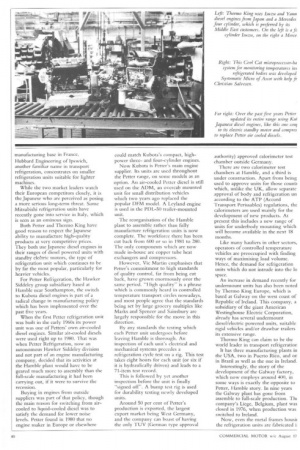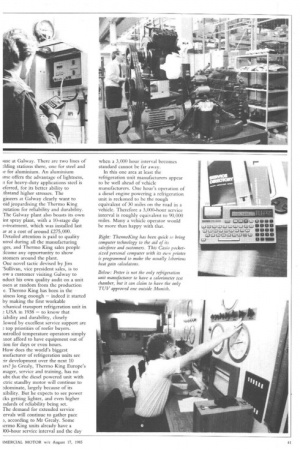OUT FREEZING THE
Page 41

Page 42

Page 43

If you've noticed an error in this article please click here to report it so we can fix it.
COMPETITION
Thermo King and Petter, market leaders in refrigeration units for temperature controlled transport, arc looking to quality control and product development to stay ahead. Tim Blakemore reports
ONTROLLED temperature
transport is one of the most specialised sectors of road Wage. Yet many of the trends fluencing how refrigeration units are anufactured and developed are mmon to other sectors.
There is an ever-increasing demand r higher standards of quality control; tended service intervals and service !Aram are very much in vogue; icroprocessor-based technology is ginning to have a serious impact; vironmental issues, particularly the II for less noisy operation, is affecting
./ow: Left: Jo Grealy, Thermo King trope's manager service and training, and is O'Sullivan, vice president sales, at their alway plant, and Below: at Petter frigeration's Humble plant: Roger Amos, es director and Vic Martin, general sales wager.
the design of components; and European legislation, specifically the lack of harmonisation in it, is of concern to manufacturers and operators.
Add to this the growing importance of Japanese companies in a market which hitherto has been dominated by European and American manufacturers and there is no doubt that the controlled temperature sector can be described as a microcosm of the whole European transport scene.
The two leading refrigeration unit manufacturers for the UK are Petter and Thermo King. At this stage it should be pointed out that the commonly used term "refrigeration unit" is not strictly accurate, for most of the units produced by both these companies and others can heat as well as cool a box, and when operating in ambient temperatures of around —20°C, in Scandinavia for example, that is precisely what they do.
Both manufacturers report recent growth in controlled temperature transport in the UK reflected in the healthy state of their order books. Vic Martin, general sales manager of Petter Refrigeration, says that his company's sales increased here by 35 per cent last year compared with 1983, which itself saw a 20 per cent increase on the year before.
Jim O'Sullivan, Thermo King Europe's vice president sales, notes that last year the number of Thermo King units sold in the UK was "the highest ever", though he now believes that growth has "flattened out".
But the two market leaders are not being allowed to have things all their own way. A relative newcomer which has begun to make inroads into the UK market, estimated to total between 3,500 and 4,000 units a year in the 7.5 to 38tonnes gross weight sector, is Carrier, an American company which has a manufacturing base in France, Hubbard Engineering of Ipswich, another familiar name in transport refrigeration, concentrates on smaller refrigeration units suitable for lighter machines.
While the two market leaders watch their European competitors closely, it is the Japanese who are perceived as posing a more serious long-term threat. Some Mitsubishi refrigeration units have recently gone into service in Italy, which is seen as an ominous sign.
Both Petter and Thermo King have good reason to respect the Japanese ability to manufacture high-quality products at very competitive prices. They both use Japanese diesel engines in their ranges of diesel powered units with standby clearic motors, the type of refrigeration unit which continues to be by far the most popular, particularly for heavier vehicles.
For Petter Refrigeration, the Hawker Siddeley group subsidiary based at Hamble near Southampton, the switch to Kubota diesel engines is part of a radical change in manufacturing policy which has been implemented over the past five years.
When the first Petter refrigeration unit was built in the early 1960s its power unit was one of Petters' own air-cooled diesel engines. Similar air-cooled diesels were used right up to 1980. That was when Pater Refrigeration, now an autonomous Hawker Siddeley division and not part of an engine manufacturing company, decided that its activities at the Hamble plant would have to be geared much more to assembly than the full-scale manufacturing it had been carrying out, if it were to survive the recession.
Buying in engines from outside suppliers was part of that policy, though the main reason for switching from aircooled to liquid-cooled diesel was to satisfy the demand for lower noise levels. Petter found in 1980 that no engine maker in Europe or elsewhere could match Kubota's compact, highpower threeand four-cylinder engines.
Now Kubota is Petter's main engine supplier. Its units are used throughout the Petter range, on sonic models as an option. An air-cooled Petter diesel is still used on the ADM, an overcab mounted unit for small distribution vehicles which two years ago replaced the popular DEM model. A Leyland engine is used in the PDL-50 trailer-mounted unit.
The reorganisation of the Hamble plant to assemble rather than fully manufacture refrigeration units is now complete. The workforce there has been cut back from 600 or so in 1981 to 280. The only components which are now made in-house are copper tube heat exchangers and compressors.
However, Vic Martin emphasises that Petter's commitment to high standards of quality control, far from being cut back, have grown enormously over the same period. "I ugh quality" is a phrase which is commonly beard in controlled temperature transport circles nowadays, and most people agree that the standards being set by large grocery multiples like Marks and Spencer and Sainsbury are largely responsible for the move in this direction.
By any standards the testing which each Petter unit undergoes before leaving Harnble is thorough. An inspection of each unit's electrical and mechanical systems precedes a refrigeration cycle test on a rig. This test takes eight hours for each unit (or six if it is hydraulically driven) and leads to a 71-item test record.
This is followed by yet another inspection before the unit is finally "signed off'", A bump test rig is used for durability testing newly developed units.
Around 50 per cent of Petter's production is exported, the largest export market being West Germany, and the company can boast of having the only TUV (German type approval authority) approved calorimeter test chamber outside Germany.
There are two calorimeter test chambers at Hamble, and a third is under construction. Apart from being used to approve units for those count] which, unlike the UK, allow separate approval of body and refrigeration un according to the ATP (Accord Transport Perissahles) regulations, the calorimeters are used mainly for the development of new products. At present this includes a new range of units for underbody mounting which will become available in the next 18 !months.
Like many hauliers in other sectors, operators of controlled temperature vehicles are preoccupied with finding ways of maximising load volume. Hence, the demand for refrigeration units which do not intrude into the In space.
An increase in demand recently for undermount units has also been noted by Thermo King Europe, which is based at Galway on the west coast of Republic of Ireland. This company, a subsidiary of the giant American Westinghouse Electric Corporation, already has several undermount diesel/electric powered units, suitable rigid vehicles and/or drawbar trailers its extensive range.
Thermo King can claim to be the world leader in transport refrigeration It has three manufacturing plants in the USA, two in Puerto Rico, and on in Brazil as well as the one in Ireland.
Interestingly, the story of the development of the Galway factory, which now employs around 4-00,. in some ways is exactly the opposite to Petter, Hamble story. In nine years the Galway plant has gone from assemble to full-scale production. Du company's Liege, Belgium, plant was closed in 1976, when production was switched to Ireland.
Now, even the metal frames housii the refrigeration units are fabricated i:
,use at Galway. There are two lines of dding stations there, one for steel and Le for-aluminium. An aluminium one offers the advantage of lightness, Lt for heavy-duty applications steel is eferred, for its better ability to thstand higher stresses. The
gineers at Galway clearly want to oid jeopardising the Thermo King Dutation for reliability and durability. The Galway plant also boasts its own int spray plant, with a 10-stage dip e-treatment, which was installed last ar at a cost of around _U75,000. Detailed attention is paid to quality ntrol during all the manufacturing Lges, and Thermo King sales people .1come any opportunity to show storners around the plant.
One novel tactic devised by Jim 'Sullivan, vice president sales, is to ow a customer visiting Galway to nduct his own quality audit on a unit osen at random from the production e. Thermo King has been in the • siness long enough — indeed it started by making the first workable
._chanical transport refrigeration unit in USA in 1938 — to know that iability and durability, closely lowed by excellent service support are top priorities of reefer buyers. )ntrolled temperature operators simply mot afford to have equipment out of -ion for days or even hours.
How does the world's biggest inufacturer of refrigeration units see ir development over the next 10 ars? Jo Grealy, Thermo King Europe's mager, service and training, has no ubt that the diesel powered unit with ctric standby motor will continue to _cloininate, largely because of its xibility. But he expects to see power cks getting lighter, and even higher ndards of reliability being set. The demand for extended service ervals will continue to gather pace ), according to Mr Grealy. Some tertno King units already have a 100-hour service interval and the day when a 3,000 hour interval becomes standard cannot be far away.
In this one area at least the refrigeration unit manufacturers appear to be well ahead of vehicle manufacturers. One hour's operation of a diesel engine powering a refrigeration unit is reckoned to he the rough equivalent of 30 miles on the road in a vehicle. Therefore a 3,000-hour service interval is roughly equivalent to 90,000 miles. Many a vehicle operator would be more than happy with that.
Right: ThermoKing has been quick to bring computer technology to the aid of its salesforce and customers. This Casio pocketsized personal computer with its own printer is programmed to make the usually laborious heat gain calculatons.












































































